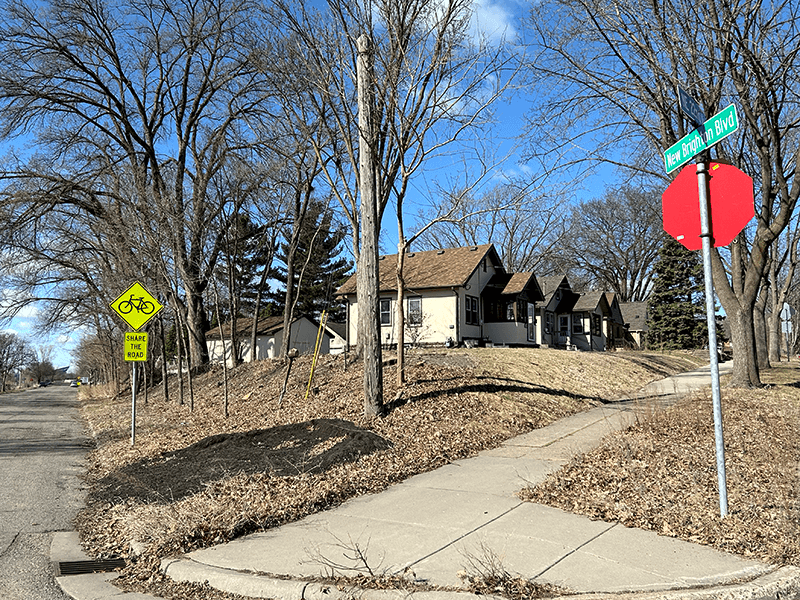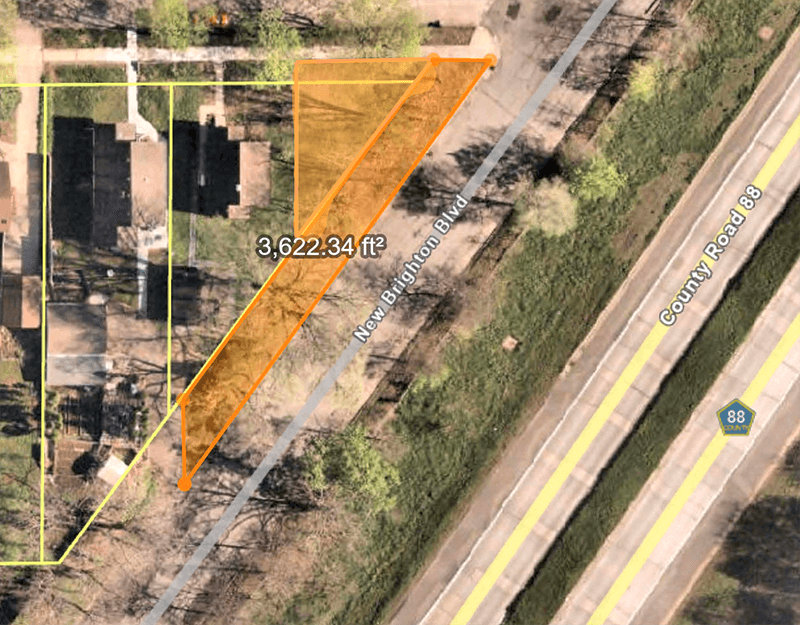
The area at 2610 22nd Ave. NE has undergone preliminary remediation. The dark circle in the foreground is what’s left of biochar created from woody plants and trees removed from the plot. (Cynthia Sowden)
A neglected strip of land in the Stinson Triangle section of the Windom Park neighborhood is about to become a pollinator paradise.
The land at the corner of 22nd Avenue and New Brighton Boulevard was taken by Hennepin County by tax forfeiture; its official address is 2610 22nd Ave. NE. The 3,622-sq.-ft. parcel is primarily a hill with a flat space at the top with maybe enough room to build a garden shed on it. It’s been choked with buckthorn and Siberian elm for years.
After acquiring it, Hennepin County put the non-homesteaded property into its vacant lot program and contracted with Landbridge Ecological of St. Paul to clear out the invasive plants and trees and create a native plant savanna to attract native pollinator insects. Landbridge has worked in Northeast before, creating Edison High School’s green campus.
At an April 16 meeting at Windom Park, approximately 20 residents listened to a presentation on pollinator gardens by Molly Phillips, a Windom Park resident and Minnesota Master Naturalist, and an overview of the project by Landbridge Senior Ecologist Patrick Kelly.
Didier Bolanos Gonzalez, a representative of Hennepin County’s Climate and Resiliency Department, was on hand to answer questions.
“The Hennepin County Climate and Resiliency Department is using guidance from the Hennepin County Climate Action Plan to leverage two tax-forfeited lots for urban agriculture and native species planting initiatives,” said Phillips in an email. “We were lucky that one of the selected lots happened to be in Windom Park.”

Above left, a Hennepin County property map shows the tax-forfeited property along New Brighton Blvd. that will be transformed into a pollinator garden. (Hennepin County)
The project is in phase one — site preparation. Landbridge is removing thatched grass and may do some controlled burns to clear the brush and noxious weeds. Some of the woodier plants have been reduced to biochar that some Windom Park residents have taken to fertilize their own gardens. Biochar is wood that is reduced to charcoal in a low-oxygen process called pyrolysis. This phase will last until August.
Phase two will begin in September. A seed mix of native wildflowers, grasses and other plants will be broadcast across the plot and under the trees and covered with an erosion control blanket. Volunteers from the Windom Park neighborhood will install plant plugs with native species.
“The site will continue to evolve over the course of the next few years as the plants develop their root systems,” Phillips noted. The maintenance phase of the garden will evolve with the seasons. Next year, the plot will be mowed occasionally to keep down weeds. The following year, spot weeding will take the place of mowing.
By season three, the planting area will be fully established and Landbridge will have fulfilled its contract with the county. Volunteer gardeners will be needed to join a coalition to maintain the site. Interested parties can reach out to Windom Park Citizens in Action at info@windompark.org